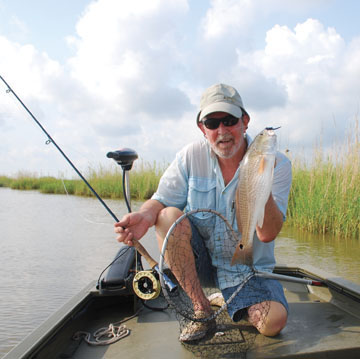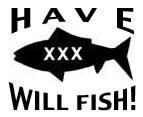
The Saltwater Magazine for Gulf Coast Fishing!
FISHING FORECASTS
| FISHING CALENDARS | ARTICLES | ADVERTISE
| SUBSCRIBE
Search Gulf Coast Fisherman's
Web Site
Past articles, specific
places or fish, etc.

Vermilion Bay Reds
How, When & Whereby Pete Cooper, Jr.
| CURRENT
MOON lunar phases |

 fter being displaced from my beloved Mississippi
River Delta by Katrina, the first place I speculated, near what would become
my new home was Vermilion Bay, roughly south of Lafayette. That day a friend
and I - each of us
fter being displaced from my beloved Mississippi
River Delta by Katrina, the first place I speculated, near what would become
my new home was Vermilion Bay, roughly south of Lafayette. That day a friend
and I - each of us
- knowing the area about equally well - didn't catch a sniff!
- A year later my rice-farming buddy from Kaplan, Durel Romaine, and I were returning from an unsuccessful trip to the bay's "Southwest Pass" when we encountered a melee of specks running shrimp just south of the mouth of "Four-mile Cut". Man, did I ever need the hit we put on 'em that afternoon.
- Another year past, Durel and I got into some really fine specks most of them between 18 and 22 inches walking Dogs along the west shoreline of Cypremort Point. And up until this past summer, I can think of a few more fish friends and I have caught in the bay, but not many and most of them "seasonal specks". And I am absolutely certain that was primarily because of a lack of familiarity with the area. Some serious prospecting was in order!
- knowing the area about equally well - didn't catch a sniff!
- So, I began trying to convince my wife Barbara that if I was to catch
any fish in these "new" waters with any regularity, I needed
a boat. And after missing three consecutive hand-made fishing days because
all my boat-owning buddies had to work, and as you might have expected
raising a little hell about it, I received her blessing to buy one.
- I must admit that the initial runs of the Sneaky Pete VII were not made onto Vermilion Bay, and I must also confess that it was a vague rumor that led Durel, his oldest son Zach, and me to use his boat to prospect the waters around Mud Point where we ended up catching 13 and a nice flounder. Well Hello! And a quick follow-up trip had similar results and led to the thought that those fish just might be fly fishable.
- They weren't yet. Another buddy and I sortied in my boat a few days later to work the same grass shoreline that had given up several nice fish on the previous trip and managed only premature releases of a rat red and a small flounder. All right, they may not have wanted flies, but I just knew they'd thump a spinnerbait. Not along that bank which had become muddy from a change in the wind's direction two days later. But a little prospecting along a short section of quiet and slightly clearer bank resulted in one fair fish. A pattern was emerging.
- Compelled to test it further, I sallied forth the next morning, which began quite favorably with two nice fish from the short bank. Then, I moved to a stretch of the bay's westernmost shoreline just above Redfish Point, and in the next hour or so caught four and lost three others. Finally! But the best part is that on my next trip, I tallied four on flies.
- There is a lot more to all of that than simply the tale of it. Vermilion Bay is indeed a tough nut to crack, but once you learn its particulars, it can give up some fine action with redfish, among others.
- The bay is directly affected by the effluent of the Vermilion River and occasionally that of the Atchafalaya. Therefore, its waters can be pretty grungy at times, especially through winter and much of spring and after a big rain event. However, by the first of June it typically begins to clear enough to fish for the reds that have probably been there all along, mid-summer through fall being primetime.
- Initially, and often in some pretty nasty looking water, fishing will be best done by focusing on areas that tend to attract the fish in numbers the more there are in a small area, the more likely one will find the enticer. Numerous small cuts drain the marshes along Mud Point and the edge of the Wildlife Refuge at and adjacent to Redfish Point. While there is always the possibility of finding fish at the mouths of those cuts, the potential has proven to be definitely better when a "drain" empties into a shallow pocket in the shoreline.
- When the water is really murky, concentrate on these areas. Take your time, too, working them thoroughly, and make some racket with that popping cork. In such conditions,that should be done entirely with a shrimp tipped jig suspended about 1-1/2' beneath a 3 inch weighted pop-ping cork.
- One thing about those jig-heads. One that is fashioned with a synthetic hair "tail" is much better than either a bare one or one dressed with a soft-plastic grub. The first case should be obvious; the second is because the thickness of the grub decreases the bite of the hook's gape, whereas the hair tail doesn't.
- Okay, once the bay's water has cleared enough to provide roughly six inches of sub-surface visibility, a spinnerbait becomes a better choice than shrimp. That is mainly because there is much less of a chance of hooking a hardhead or a stingray.
- A lot of these lures are available in tackle stores and catalogs, but I prefer to create my own for economic reasons.
- "My Way" begins with a quarter-ounce round jig-head the type with a short stout hook. I then snap a gold #4 Colorado-type Hildebrandt jig-spinner to the head and smash the snap closed with pliers. Finally, I dress the jig-head with a soft-plastic grub a purple H&H "Baby Bull Minnow" being presently preferred. The limber connection between the spinner and the jig head greatly lessens the chance of it getting bent by a red!
- Here I must declare that while I don't especially care for the bay's normally "cloudy" water, I absolutely love its grass shorelines! They are just like those of yesteryear behind Buras and Empire, and like those old favorites, the ones around the perimeter of Vermilion Bay hold lots of reds.
- Typically, they are punctuated with small points and pockets. For some reason that I don't understand and may be simply coincidence, most of the reds I have caught here have been from the little pockets and close to the bank. Therefore, it's best to make the casts parallel to the edges of the pockets and no more than three feet from the grass.
- Immediately begin a stop-and-go retrieve - "go" by raising the rod's tip just fast enough to let you feel the throb of the spinner, then "stop" while you quickly drop the rod's tip and retrieve line. Frequently a strike will come as a sharp "thump" followed by slack line the result of the fish coming at you when it hit the lure. When that happens crank like hell and set the hook on hope alone.
- The eastern reaches of Vermilion Bay are best accessed from a public launch at Cypremort Point. Coming from the Lafayette area, that is gained by taking the Darnall Road exit off US 90 south of New Iberia and following it south to LA 83, then down 83 through Weeks Island to LA 319 and on to the Point. From points further east take the LA 83 exit off US 90 at Baldwin, then follow it to LA 319 and onward. In my experiences, though, this area is best for specks during mid to late fall.
- The launch at Intracoastal City is gained by taking LA 82 off LA 14 in Abbeville, following 82 to LA 333 and then LA 333 to the ramp. That is a well-designed parish-maintained facility with plenty of parking spots and the nearby store, so although it may all look pretty remote on a map and it is it's not foreboding. It will also be crowded on weekends, mainly with folks seeking specks offshore, so be aware.
- There are two ways to get from the ramp to the bay. The first is to jog east up the Intracoastal Canal until you see the head of "Four-mile Cut" on the right. Take this to the bay; Mud Point will be on your right and Redfish Point dead ahead.
- You can also jog west from the ramp to the first cut on the left. That's the old river-channel. Follow it around past a pair of camps and a tank battery (Use it as a landmark for your return trip.). Mud Point will be straight in front of you, and a lot of good-looking bank will be to your right.
- And a lot of redfish will be awaiting you. See you there!

